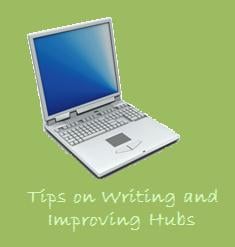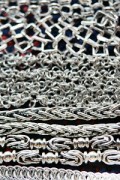Tips on Writing and Improving Hubs

Writing and publishing hubs is an easy task. Of course the way you go about doing it may help you or go against you.
When writing hubs here are some tips you can use and/or follow to help improve your hubs and make them look more professional and credible. Knowing this is important especially if you hope to gain reader followers and be a more successful hubber.
Including Pictures in Your Hubs
A picture is worth a thousand words. We have all heard this phrase endless times and it is true. A picture can say so much even before a person dives into a body of work. It is probably the first thing a person sees and notices. So, having a fitting image in your hub that attracts the eye is key. It doesn't necessarily need to be a professionally created image but it should be one that catches the eye of the reader and that also fits with the content of the hub. If you don't have an image of your own to use you can always use an image that is published online. Before you do that, however, make sure that you are allowed to use that image. If you are allowed to use the image then go ahead and use it in your hub but make sure to include the source of the image in the caption.
When your hub is displayed on your HubPages profile, throughout HubPages, on Facebook, or on other sites usually an image will always appear next to it. Having an image therefore is a great idea to have in your hub so before you publish your hub be sure to include at least one image in it. Having an image displayed next to your hub summary and link can potentially increase your hub views so don't publish a hub without it. A hub without a picture has a higher chance of ending up unnoticed no matter how great its content is.And that is something you don't want to happen.
Using Different Capsules in Your Hubs
Have more than one text capsule in your hubs and include capsule subtitles in each capsule. Capsule subtitles can improve your Google search rankings, especially if they have relevant keywords in them. They also help divide your hubs into sections and let readers known what each section is about even before they start reading it. Make sure that your capsule subtitles are descriptive, have relevant keywords and summarize what the section is about.
Include an amazon capsule in your hubs. Even if you are not part of Amazon Associates (Amazon's affiliate program) it is a good idea to include this capsule in your hubs. This will allow you to include books that people can read that will give them more information on the topics that you are writing about. If you are writing about certain products, including the Amazon capsule will allow you to include links to those products. Readers will be able to find out easily more about those products, read relevant customer reviews, and purchase them if they need them, all by clicking on the product links in the Amazon capsule. There is no need for them to search for those products on the web because you've already provided links to those products in your hubs, which is very convenient.
If you are writing recipe hubs including the YouTube capsule can be a very effective tool for your readers. In this capsule you can include YouTube videos that show readers how to prepare the dish you are writing about. Even if your recipe instructions are very easy to understand and follow, having YouTube videos that showcase how to prepare the dish can make a big difference, especially since some readers prefer visual instructions to written ones when it comes to preparing a meal.
Including Polls in Your Hubs
Include polls in your hubs. This allows your readers to engage with the hubs and lets you gather valuable feedback on the topic that you are writing about. Let's say you are writing a hub about a particular author who has published many books. You can include a poll in your hub that lets readers pick their favorite book by that author. You will be able to see which book by that author is the most read book.
Using Quotes in Your Hubs
If you are using quotes in your hubs make sure to include them in quotation marks. Also, provide the name(s) of the individual(s) you are quoting. By doing this your hub will sound more credible and it will not look like you are making up the quotes or plagiarizing, which is not allowed.
Using Data and Factual Information in Your Hubs
If you are using factual information such as data or charts and graphs in your hubs be sure to include a source of where this information comes from. This will make it more credible and readers won't be skeptical of the numbers.
When including data in your hubs it may be more presentable if it is showcased in a table rather than just written out in paragraph form. You can include that data in an image or you can use the table capsule that is available for you when writing a hub.
Using Page Dividers in Your Hubs
When writing and putting together a hub that is lengthy and has a lot of information for readers to digest it may be a good idea to include page dividers in your hub.
A page divider is an image that stretches the length of the hub page but is narrow in width. Including a page divider before each new section will make it easier for people to read and follow your hub. It will also improve the look of the hub as well. It will look more alive and will help to keep the reader drawn to the hub they are viewing.
One of the ways to find page dividers to use for your hubs is to Google them up. Personally, I prefer to make my own page dividers. Not only do you not have to worry about copyright issues but your page dividers become unique and it doesn't look like you are copying anyone.
If you are writing a recipe hub for example, a page divider can be photos of the recipe you are sharing with others. It can be a photo of the final product displayed one after another, or it can be photos of each of the steps in the recipe along with the final product. Also, you can use ingredient photos or any other images that relate to the hub you are writing. They don't have to be photos taken with a camera. They can be drawn images as well. The choice is yours and the possibilities are endless.
Doing Research for Your Hubs
When writing a hub you may find that you don't have enough information to make a full informative hub. If that is the case don't hesitate to do some research online. It might take up some of your valuable time but it will insure that your hub is as informative as it can be. There are many online sources you can turn to for information. You can do a Google search for the topic you are writing about or you can go to wikipedia. Physical books or newspapers and magazines can help as well. No matter where you get information for your hub don't hesitate to use it. It will help improve your hub. And be sure to credit the source where necessary as you don't want to get accused for plagiarizing.
© 2012 Lena Kovadlo








